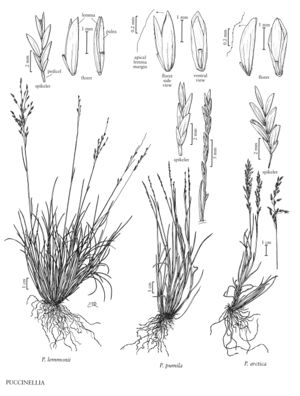Puccinellia lemmonii
Plants perennial; cespitose, not mat-forming. Culms 5-40 cm, usually erect. Leaves basally concentrated; ligules 0.8-2.2 mm, obtuse to acute, mostly entire, sometimes slightly erose; blades involute, 1.2-1.9 mm wide when flattened. Panicles 2-18 cm, compact to diffuse at maturity, lower branches ascending to descending, usually spikelet-bearing to the base; pedicels scabrous, lacking tumid epidermal-cells. Spikelets 3.5-8 mm, with 2-6 florets. Glumes rounded over the back, veins obscure, apices acute to obtuse; lower glumes 0.7-1.5 mm; upper glumes 1.4-3 mm; calluses with a few hairs; lemmas 2.4-4 mm, herbaceous, mostly smooth, usually glabrous, sometimes with a few hairs near the base, principally along the veins, backs usually rounded, sometimes weakly keeled distally, 5-veined, veins obscure, midveins often slightly scabrous and prominent in the distal 1/2, often extending to the apical margins, lateral-veins not extending to the margins, apical margins ranging from smooth to scabrous, entire, not white, apices acute, entire; palea veins glabrous or shortly ciliate proximally, uniformly scabrous distally; anthers 1-2 mm. 2n = 14.
Distribution
Wash., Calif., Oreg., Mont., Wyo., Idaho, Nev.
Discussion
Puccinellia lemmonii grows in non-littoral saline environments in the western portion of the contiguous United States. Reports from Saskatchewan are probably based on depauperate specimens of P. nuttalliana.
Selected References
None.
Lower Taxa
"decumbent" is not a number.
